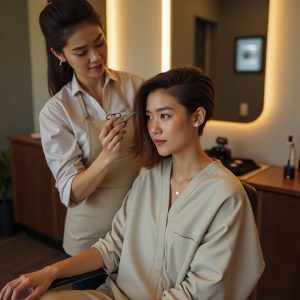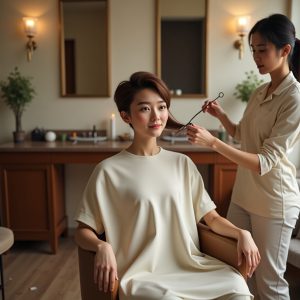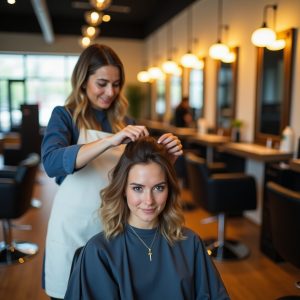design
Although hair salons are booming, bringing a wide variety of hair design technology and tools, the innovative hand tools bring some problems, such as radio-ulnar clubhands due to the overuse of hands and wrong exertion, involving occupational injury and the danger of use. The issue of occupational injury occurs with the development of every industry.

Using the Observational Method to understand the operational behavior and job requirements using QFD to assess the design of the curing iron in the market is the most corresponding to the job requirements. The design of the curing iron for hair salons faces too many requirements in the market so it produces special shapes for the hairstyle or for the convenience of using handles however, these changes can’t improve the problem of customers being burned and the operation of hands.
The bad hand tool design may also affect the force of the hands’ muscles using it for a long time will cause tiring of muscles and wrists easily, causing diseases of muscles and bones, and then forming occupational injury further. This study’s results can reduce the rate of occupational injuries in hair stylists’ hands. The results of this study can reduce the incidence of occupational injuries in hairstylist hands and provide design assessment.
Though the number of hair-dressers is limited, compare the incidence of work in January 2003 and June 2006 among other industry groups, accounting for the hairdressing industry compensation cases related to the hand-wrist rate of about 24 %. Further, the number of such insurance claims annually since 1998, because of growing women’s beauty and allied sectors, the greatest portion of the musculoskeletal disorders of the situation.
The poor postures and modes of operation like combing hair design, washing, and drying must be avoided to minimize the barber. Scant attention has been given by researchers to hairdressers’ neck/shoulder problems. Biomechanics Workload quantitative measurement of the female’s neck and shoulders hairstylist during and after a treatment session. Intensive activity risk from dangerous mechanical hair is still confined. Although there exists a host of hairstyles in a parlor, its utility is booming but with hazards.
Preliminary research
A pilot experiment was made for design direct observation with the aid of the original utility of Electric Roller Parsers under actual operating situations. A preliminary study was conducted by direct observation of the actual use of the existing Electric roller parses.
Interviews were conducted to know in general how customers respond to the existing Electric roller, keratin oil, hair design, hair style, iron hair design parses on the market today as well as the characteristics of customers towards the desired Electric roller parses in the future. The interview is an initial level that serves as a reference in designing the study questionnaire. It is likewise a technique to get a preliminary photo of patron expectancies for designing an ergonomic.
 QFD Work Program
QFD Work Program
The accrued survey questionnaires were examined for their validity and reliability through the use of the SPSS software program V.22 . Then, the accumulated information was processed through the usage of the QFD layout via House of Quality. QFD quality control by the Japanese master Yoji Akao and important quality control theory proposed by Shigeru Mizuno. QFD includes the quality and function and expands the three parts.
Quality is the quality of the house to be achieved by the quality requirements function, also known as function, that is after listening to customers functions aggregated demand, also appellation customer demand expand that is, to achieve a series of product quality carried out by the process integration, including conceptual propose, design, manufacture and service processes.
Methods Used by Customers to Straighten Hair
Straightened Hair without the use of thermal hair design appliances has been prevalent in women who fall under Category 2 and 3 since it is hard to predict when heat damage will appear. The three most identified methods are threading, banding, and wrapping methods.
The Threading method is a styling technique that was adopted from the traditional African Threading methods used in Africa. Using thread, hair is straightened by wrapping thread along the shaft of hair from root to tip. The banding method is a similar process, but instead of wrapping thread along the hair shaft, small elastic bands are used. The wrapping method has been around for years and used by professionals however, the natural hair community has adopted and taken this technique by removing heat from the conventional process.
This technique is done by wrapping all hair in one management around the head and securing it with bobby pins or hair clips, hair design, serum, keratin oil, hair gell. All of these skills are done on damp hair, which means that hair has to be set and be given a lot of time to dry. Styles that have been achieved through these methods are not as smooth and sleek as those that have been done with the use of a thermal heat appliance.
Even though these methods require an enormous amount of effort and time and do not yield the same results, it is evident from the substantial amount of information provided about these techniques that there is a great desire to achieve straightened hair in the natural hair community.
 Thermal Characterization of Hair
Thermal Characterization of Hair
The studies on the effect of heat on hair design involve conducting a heat source on a single fiber of hair or bundle of fibers. During the studies, the major parameters that were defined were the changes in tensile properties, amount of protein decomposition, and damage to the cuticular layer. Rosenfeld et al. reported that raising heat lowers tensile properties in hair.
Monteiro et al. used thermal analysis to demonstrate the alteration of keratin in response to bleach and chloro treatments. Humphries et al. studied commercially available thermo mechanical analysis as a tool to identify damage as well as chemical changes in hair caused by various treatments. Milczarek et al. discussed in detail the thermal transition of keratin in hair at different levels and its correspondence with the amount of water absorbed by hair.
Cao examined the melting behavior of keratin microstructures in human hair. Harper et al. probed the effectiveness of heat styling using a curling iron by monitoring the degree of shape retention and the lifespan of curl formation. Experiments resulted in finding that past 100◦C, the effectiveness is very low, and negative effects on curling effectiveness occur at temperatures higher than 200◦C. To be noted, of all the above experimental studies Dussaud et al. proposed work that showed the gradual diminishing of natural curls in human hair.

